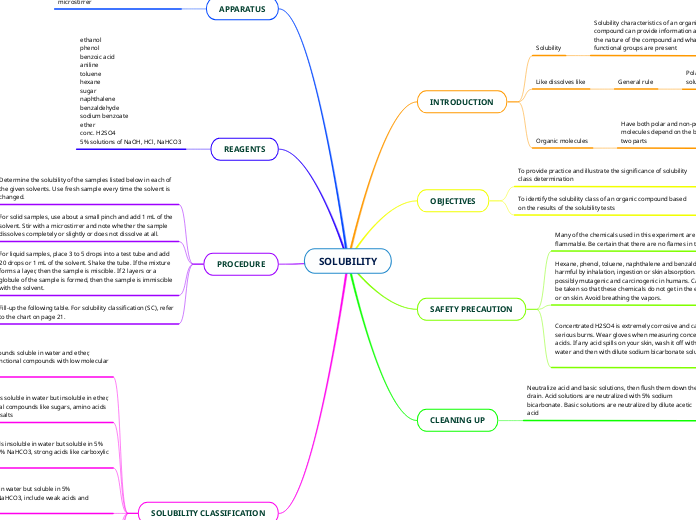
Solubility
Solubility characteristics of an organic compound can provide information as to the nature of the compound and what functional groups are present
A measure of the equilibrium between the pure solute and its solution
Affected by solute-solvent interactions and intermolecular forces present in the pure solute
A compound is soluble if 30 mg of the compound or 3 drops of liquid sample dissolves in 1 mL of the solvent
Like dissolves like
General rule
Polar solvent is expected to readily dissolve only polar
solutes, and non-polar solvent only non-polar solutes
Organic molecules
Have both polar and non-polar part; Solubility of molecules depend on the balance between these two parts
As percentage of hydrocarbon portion increases,
properties of the compound approach those of the parent hydrocarbon
o Results in decreased water solubility and increased organic solvent solubility (ex. ether)
To provide practice and illustrate the significance of solubility class determination
To identify the solubility class of an organic compound based on the results of the solubility tests
Many of the chemicals used in this experiment are highly flammable. Be certain that there are no flames in the vicinity.
Hexane, phenol, toluene, naphthalene and benzaldehyde are harmful by inhalation, ingestion or skin absorption. Aniline is possibly mutagenic and carcinogenic in humans. Care should be taken so that these chemicals do not get in the eyes, mouth or on skin. Avoid breathing the vapors.
Concentrated H2SO4 is extremely corrosive and causes serious burns. Wear gloves when measuring concentrated acids. If any acid spills on your skin, wash it off with plenty of water and then with dilute sodium bicarbonate solution.
Neutralize acid and basic solutions, then flush them down the drain. Acid solutions are neutralized with 5% sodium bicarbonate. Basic solutions are neutralized by dilute acetic acid
Place residual nonhalogenated chemicals such as diethyl ether, hexane, etc. in the waste container for nonhalogenated liquids. Flush all aqueous solutions down the drain.
test tubes
test tube rack
weighing scale
droppers
10 mL graduated cylinders or 10 mL pipets
aspirator
microstirrer
ethanol
phenol
benzoic acid
aniline
toluene
hexane
sugar
naphthalene
benzaldehyde
sodium benzoate
ether
conc. H2SO4
5% solutions of NaOH, HCl, NaHCO3
Determine the solubility of the samples listed below in each of the given solvents. Use fresh sample every time the solvent is changed.
For solid samples, use about a small pinch and add 1 mL of the solvent. Stir with a microstirrer and note whether the sample dissolves completely or slightly or does not dissolve at all.
For liquid samples, place 3 to 5 drops into a test tube and add 20 drops or 1 mL of the solvent. Shake the tube. If the mixture forms a layer, then the sample is miscible. If 2 layers or a globule of the sample is formed, then the sample is immiscible with the solvent.
Fill-up the following table. For solubility classification (SC), refer to the chart on page 21.
● S1
o compounds soluble in water and ether,
monofunctional compounds with low molecular
weight
● S2
o compounds soluble in water but insoluble in ether,
polyfunctional compounds like sugars, amino acids
and organic salts
● A1
o compounds insoluble in water but soluble in 5%
NaOH and 5% NaHCO3, strong acids like carboxylic
acids
● A2
o compounds insoluble in water but soluble in 5%
NaOH, insoluble in 5% NaHCO3, include weak acids and phenols
●B
o compounds insoluble in water but soluble in 5% HCl,
basic compounds like amines
●N
o neutral compounds, insoluble in water, 5% NaOH,
5% HCl but soluble in concentrated H2SO4, these are oxygen containing compounds (alcohols, ethers, aldehydes, ketones and esters) and alkenes
●I
o inert compounds, insoluble in water, 5% NaOH, 5%
HCl and concentrated H2SO4, include aromatic and aliphatic hydrocarbons, alkyl and aryl halides